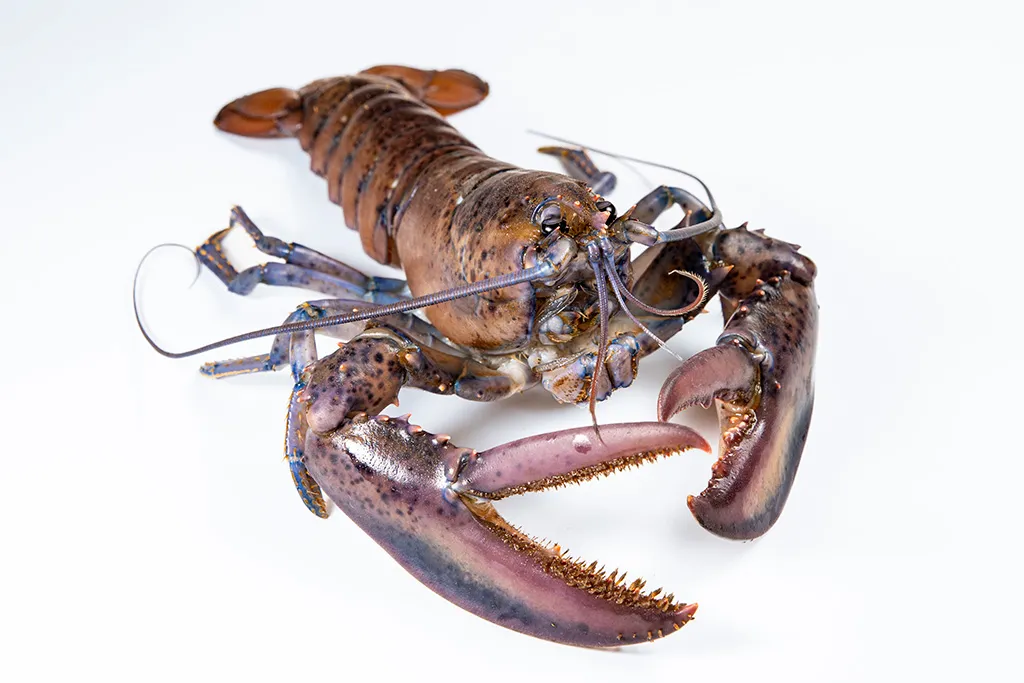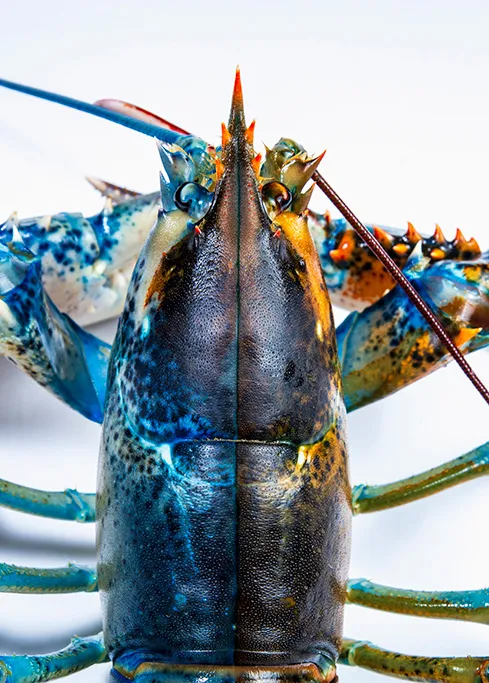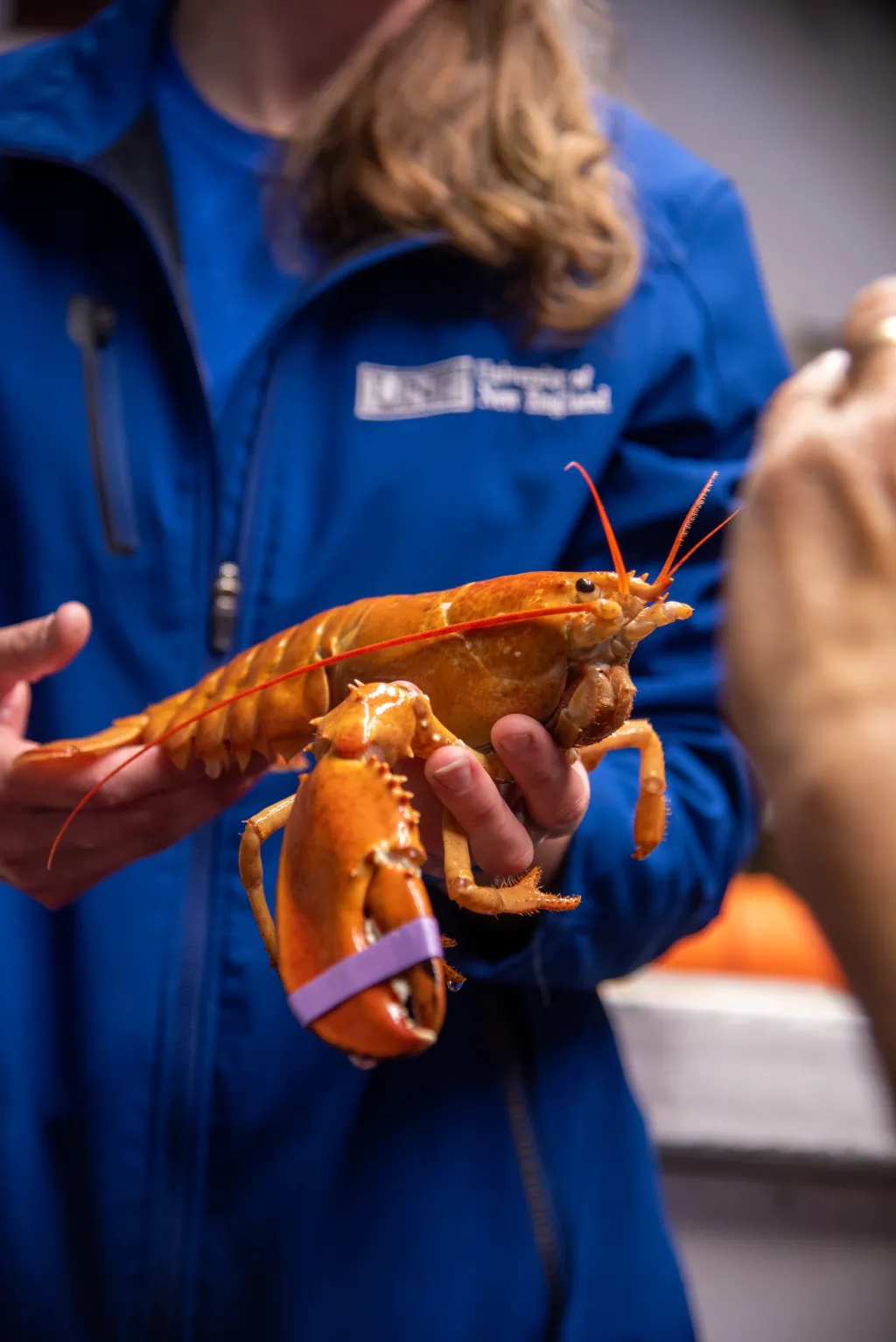
The project aims to uncover the genetic basis for the coloration of rare lobsters through non-harmful methods
With the donation of two, new rare-colored lobsters, the University of New England has launched an ambitious research project to decode the genetic basis for rare lobster coloration.
A lobster typically appears brown or “mottled” in appearance, though in rare cases they can come in various colors, including blue, yellow, orange, red, and even white or albino. Researchers say the precise genetic mechanisms responsible for these extraordinary variations remain largely unknown.
UNE’s Markus Frederich, Ph.D., professor of marine sciences, is hoping to change that.
Frederich and his students are leading an effort to better understand the molecular basis for these lobsters’ colorful shells. The team is currently developing non-invasive methods for extracting genetic samples from the lobsters, which Frederich says may provide insight into why some lobsters diverge from their typical coloration.
“At this point, no one really knows in detail why some lobsters develop these multicolor variations, though we do have some theories,” Frederich remarked. “We hope to use this gene expression research to study the molecular biology of these creatures in a way that is not harmful to the lobsters.”
The research team doesn’t have to look far for subjects.
With its reputation for excellence in the marine sciences, UNE has become a magnet for these rare lobsters in recent years, housing an impressive lineup including orange, yellow, split-colored, and calico varieties — each with rarity ranging from 1-in-30 million to 1-in-50 million.
And now, UNE is home to another rare pair of oceanic oddities.

Fig

Currant
The first is a blue and brown split lobster, the odds of finding which are one-in-50 million. The dual-colored bottom dweller has been named Currant and was donated by Boothbay resident Eben Wilson on the FV Lettie Elise.
Joining Currant is Fig, a one-in-a-million baby purple lobster, who was caught, raised, and donated to the Arthur P. Girard Marine Science Center by UNE alum and graduate research assistant Aubrey Jane B.S. ’20 (Marine Biology).
In June 2023, UNE welcomed Peaches, a one-clawed, orange lobster who became a viral sensation.
In addition to studying the DNA of the center’s full-grown lobsters, UNE undergraduates working on the project are currently tending to the eggs of an orange lobster to see how many of the offspring will be orange. They expect the eggs to hatch this spring.
“These rare lobsters appearing more and more on social media, and no one seems to know exactly why they turn these different colors,” Frederich said. “We have access to all these different lobsters, and we have the students who are eager to do the research. We thought, ‘Let’s jump on this.’”

Peaches
And while the researchers plan to study UNE’s resident lobsters, Frederich said he is in talks with several local lobstermen to create research partnerships that would see rare lobsters brought to UNE for study before they are released back into the wild.
Charles Tilburg, Ph.D., academic director of UNE’s School of Marine and Environmental Programs, said the research effort is a way for UNE to meaningfully engage with industry in support of student experiential learning.
“This is the type of project that plays to both UNE’s strengths and our goals,” he said. “Dr. Frederich and his team are performing novel, interesting research while partnering with a local industry, providing outstanding training for our students, and answering important questions in the field.”
Photos of Currant and Fig can be found here, courtesy of Markus Frederich.
News Coverage about the Project
- Mysteries Behind “1-In-50-Million” Super Rare Lobster Colors May Soon Have An Answer (IFL Science)
- UNE receives colorful crustaceans for DNA research (WGME)
- UNE receives colorful crustaceans for DNA research (WPFO)
- "It's an exciting journey" - UNE begins research into DNA of rare, multicolored lobsters (Fox 22 Bangor)
- University of New England study to use DNA to examine why lobsters sometimes have strangely colored shells (Spectrum News Maine)
- Scientists want to crack the mystery of Maine’s oddly colored lobsters (Bangor Daily News)